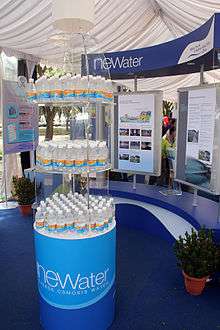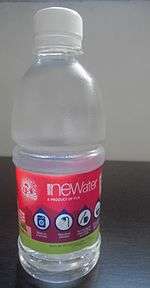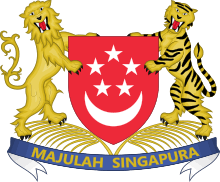NEWater
NEWater is the brand name given to highly treated reclaimed wastewater produced by Singapore's Public Utilities Board. More specifically, conventionally treated wastewater (sewage) is further purified to produce NEWater by using advanced treatment technologies(microfiltration and reverse osmosis membranes, and ultraviolet irradiation). The water is potable quality and is added to drinking water supply reservoirs where it is withdrawn and treated again in conventional water treatment plants before being distributed to consumers. Currently, however, most of the NEWater is used by industries requiring high purity non-potable production water.


History
Singapore considered water recycling to augment its limited fresh water supply starting in the 1970s.[1] A Master Plan drafted in 1972 identified water reclamation and desalination as alternatives to reduce dependence on imported water from Malaysia. Subsequently, an experimental water reclamation treatment plant was built in 1974, but the operation was terminated after only one year due to costs and reliability issues.[2]
In 1998, the Public Utilities Board (PUB) and the Ministry of the Environment and Water Resources (MEWR) initiated the Singapore Water Reclamation Study (NEWater Study). [3] The aim was to determine if NEWater was a viable source of raw water for Singapore's needs. NEWater and desalination both were explored to reduce reliance on water imported from Malaysia, which has long been a source of friction between the Malaysian and Singapore governments.[4] The Malaysian government is treaty-bound to sell water to Singapore until 2061, but it has no obligation to do so after that date.[5]
In 2001, PUB initiated efforts to identify non-potable uses of water. NEWater, because of its high quality, became the supply of choice for industries' demands. This use provided an outlet for this new water supply without increasing the demand on the limited potable water supply.[6]
The PUB launched NEWater to the public in 2003, with the opening of the first two NEWater plants - the Bedok and Kranji plants - as well as the NEWater Visitor Centre.[7] In anticipation of the potential public concerns over the safety of recycled water, NEWater was carefully implemented. The PUB was cautious in its usage of terms, avoiding terms such as 'wastewater' or 'sewage' that carried a negative connotation.[8] Sewage treatment plants were renamed to 'water reclamation plants' and sewage or wastewater were referred to as 'used water'.[9] This contributed to a positive framing of NEWater, enhancing public acceptance of reused water. In addition, the government extensively engaged the public through exhibitions and advertisements to educate them about NEWater.[10] The NEWater Visitor Centre, which allows people to view the NEWater treatment process, was also opened to enhance visitors' understanding of how NEWater is produced.[11] These public engagement efforts were aimed at correcting any misunderstandings people might have towards recycled water and increasing public support for reused water.
Production
The first NEWater plant was completed in May 2000. Singapore currently has four operational NEWater factories, at Bedok, Kranji, Ulu Pandan and Changi. The Bedok and Kranji factories were commissioned in 2002, the Ulu Pandan plant in March 2007 and the Changi plant in August 2009.[12] A plant at Seletar, commissioned in February 2004, was closed in 2011,[13] as the PUB implemented its plan to centralize the treatment of used water, under the Deep Tunnel Sewerage System.[14] In January 2017, a new NEWater plant was launched at Changi, and is the first plant to be jointly developed by a foreign and local company.[15]
The Bedok and Kranji plants are operated by the Public Utilities Board, while the Ulu Pandan and Changi plants are under DBOO concessions by Keppel Seghers[16] and Sembcorp Industries[17]
There is a Visitor Centre in the NEWater factory in Bedok, near the Singapore Expo Tanah Merah MRT station.[18] The visitor centre was awarded the Best Sightseeing/Leisure/Educational Programme at the 20th Tourism Awards 2005 and the IWA Marketing & Communication Award in 2006.[19]
The visitor centre provides multiple free programmes to educate the public regarding the technologies and production of NEWater:
- NEWater Scientist Program – Students take on the role of NEWater Scientists and explore the visitor centre[20]
- Outdoor Classroom – Host fun activities and experiments that help students learn about reverse osmosis and other NEWater processes[21]
- Water Ambassadors – Small workshops that teach uniformed groups (i.e. National Cadet Corps and Scouts Association) skills to be water ambassadors[22]
Procedure
NEWater is produced by a multiple-barrier water reclamation process:
- first stage of the NEWater production process, uses microfiltration/ultrafiltration to remove suspended solids, colloidal particles, disease-causing bacteria, some viruses and protozoan cysts. The filtered water after passing through the membrane contains only dissolved salts and organic molecules.
- second stage of the NEWater production process, uses reverse osmosis (RO). A semi-permeable membrane filters out contaminants such as bacteria, viruses, heavy metals, nitrates, chlorides, sulfates, disinfection by-products, aromatic hydrocarbons, and pesticides. NEWater is thus free from viruses and bacteria and contains very low levels of salts and organic matter. At this stage, the water is of potable quality.
- third stage of the NEWater production process, is a safety precaution. UV disinfection is used to ensure that all organisms are inactivated and the purity of the water can be guaranteed. After adding some alkaline chemicals to restore the pH balance, NEWater is ready for use.
Applications
The total capacity of the plants is about 20 million US gallons per day (76,000 m3/d). Some 6% of this is used for indirect potable use, equal to about 1% of Singapore's potable water requirement of 380 million US gallons per day (1,400,000 m3/d). The rest is used at wafer fabrication plants and other non-potable applications in industries in Woodlands, Tampines, Pasir Ris, and Ang Mo Kio.
Government figures show the country's NEWater plans can meet up to 40% of Singapore's current needs, and the figure is expected to go up to 55% by 2060.[23]
Potability
The quality of NEWater consistently exceeds the requirements set by US EPA and WHO guidelines and is cleaner than Singapore's other water sources.[24]
The following table compares the water quality of NEWater to the WHO and USEPA standards.[25]
| Quality Chart | ||
|---|---|---|
| Water Quality Parameters | NEWater | USEPA /WHO Standards |
| A) Physical | ||
| Turbidity (NTU) | <5 | 5/5 |
| Colour (Hazen Units) | <5 | 15/15 |
| Conductivity (μS/cm) | <250 | Not Specified |
| pH Value | 7.0–8.5 | 6.5–8.5 |
| Total Dissolved Solids (mg/L) | <150 | 500/1000 |
| Total Organic Carbon (mg/L) | <0.5 | -/- |
| Total Hardness (CaCO3)(mg/L) | <50 | Not Available |
| B) Chemical (mg/l) | ||
| Ammoniacal nitrogen (as N) | <1.0 | -/1.2 |
| Chloride (Cl) | <20 | 250/250 |
| Fluoride (F) | <0.5 | 4/1.5 |
| Nitrate (NO3) | <15 | 10/11 |
| Silica | <3 | -/- |
| Sulphate (SO4) | <5 | 250/250 |
| Residual Chlorine (Cl, Total) | <2 | 4/5 |
| Total Trihalomethanes (as mg/l) | <0.08 | 0.08/- |
| C) Metals (mg/l) | ||
| Aluminum | <0.1 | 0.05–0.2/0.2 |
| Barium (Ba) | <0.1 | 2/0.7 |
| Boron (B) | <0.5 | -/0.5 |
| Calcium (Ca) | 4 - 20 | -/- |
| Copper (Cu) | <0.05 | 1.3/2 |
| Iron (Fe) | <0.04 | 0.3/0.3 |
| Manganese (Mn) | <0.05 | 0.05/0.4 |
| Sodium | <20 | -/200 |
| Strontium (Sr) | <0.1 | -/- |
| Zinc (Zn) | <0.1 | 5/3 |
| D) Bacteriological | ||
| Total Coliform Bacteria (Counts/100 ml) | Not detectable | Not detectable |
| Enterovirus | Not detectable | Not detectable |
| Heterotrophic Plate Count (CFU/ml, 35 °C, 48 h) | <300 | <500/- |
References
- Water management in Singapore. International Journal of Water Resources Development, 22(2), 227–240, p. 230
- Lee Poh Onn (2005). "Water Management Issues in Singapore" (PDF). Centre for Khmer Studies.
- "Singapore Water Reclamation Study, Expert Panel Review and Findings" (PDF). United Water Technologies. 2002.
- Zhang, S.X.; V. Babovic (2012). "A real options approach to the design and architecture of water supply systems using innovative water technologies under uncertainty" (PDF). Journal of Hydroinformatics.
- Chew, Valerie. "Singapore-Malaysia Water Agreements". Singapore Infopedia. Retrieved 23 November 2014.
- History of NEWater Archived 10 June 2013 at the Wayback Machine
- PUB. "PUB, Singapore's National Water Agency". PUB, Singapore's National Water Agency. Retrieved 17 November 2019.
- Leong, Ching (2010). "Eliminating 'Yuck': A Simple Exposition of Media and Social Change in Water Reuse Policies". International Journal of Water Resources Development. 26(1): 111–124.
- Tan, Thai Pin (15 January 2018). "NEWater in Singapore". Global Water Forum. Retrieved 17 November 2019.
- Tan, Thai Pin (15 January 2018). "NEWater in Singapore". Global Water Forum. Retrieved 17 November 2019.
- Tan, Thai Pin (15 January 2018). "NEWater in Singapore". Global Water Forum. Retrieved 17 November 2019.
- The 3rd National Tap Archived 28 May 2016 at the Wayback Machine
- A Complete Makeover Archived 1 August 2013 at the Wayback Machine
- "Fact Sheet – NEWater in Singapore" (PDF). Legislative Council of Hong Kong. Research Office, Information Services Division, Legislative Council Secretariat. 26 February 2016. Retrieved 8 June 2017.
- Boh, Samantha (18 January 2017). "Singapore launches fifth Newater plant at Changi, boosting water supply". The Straits Times. Singapore Press Holdings. Retrieved 8 June 2017.
- NEWater to supply 30% of Singapore's water needs by 2011: PM
- PUB awards contract for NEWater plant at Changi to Sembcorp
- "NEWater Visitor Centre". Archived from the original on 19 April 2012. Retrieved 24 March 2012.
- "NEWater Visitor Centre". Archived from the original on 19 April 2012. Retrieved 24 March 2012.
- "The NEWater Scientist Programme". PUB. Archived from the original on 2 October 2014. Retrieved 23 November 2014.
- "Outdoor Classroom". PUB. Archived from the original on 2 October 2014. Retrieved 23 November 2014.
- "Wanted: Water Amassadors". PUB. Archived from the original on 2 October 2014. Retrieved 23 November 2014.
- "PUB NEWater". Singapore Public Utilities Board. Retrieved 15 November 2017.
- Public Utilities Board, NEWater FAQ
- "NEWater Quality". PUB. Archived from the original on 1 December 2014. Retrieved 23 November 2014.
